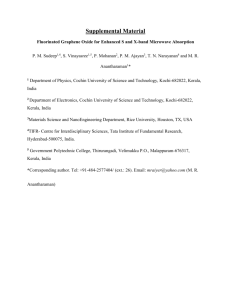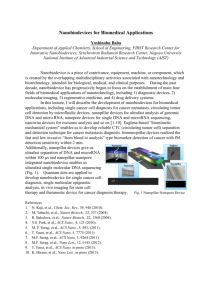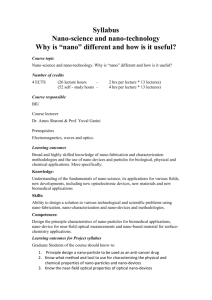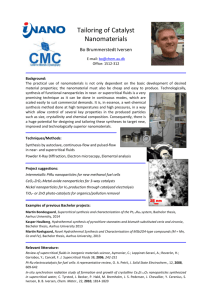报告摘要及报告人简历 - 北京大学化学与分子工程学院
advertisement
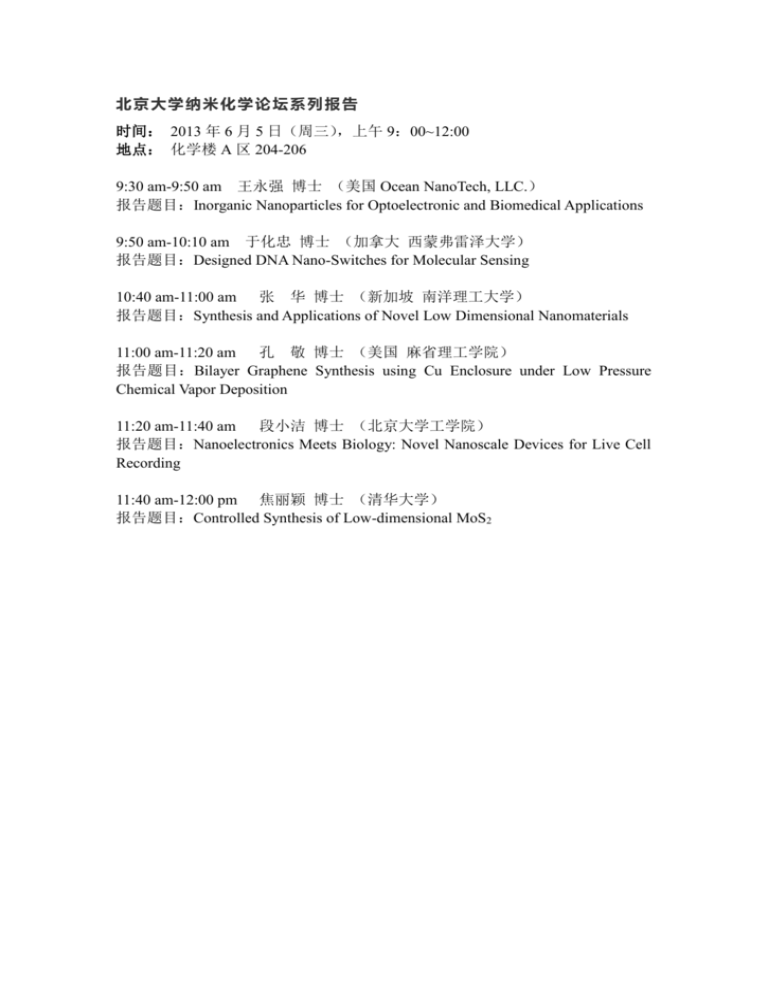
北京大学纳米化学论坛系列报告 时间: 2013 年 6 月 5 日(周三),上午 9:00~12:00 地点: 化学楼 A 区 204-206 9:30 am-9:50 am 王永强 博士 (美国 Ocean NanoTech, LLC.) 报告题目:Inorganic Nanoparticles for Optoelectronic and Biomedical Applications 9:50 am-10:10 am 于化忠 博士 (加拿大 西蒙弗雷泽大学) 报告题目:Designed DNA Nano-Switches for Molecular Sensing 10:40 am-11:00 am 张 华 博士 (新加坡 南洋理工大学) 报告题目:Synthesis and Applications of Novel Low Dimensional Nanomaterials 11:00 am-11:20 am 孔 敬 博士 (美国 麻省理工学院) 报告题目:Bilayer Graphene Synthesis using Cu Enclosure under Low Pressure Chemical Vapor Deposition 11:20 am-11:40 am 段小洁 博士 (北京大学工学院) 报告题目:Nanoelectronics Meets Biology: Novel Nanoscale Devices for Live Cell Recording 11:40 am-12:00 pm 焦丽颖 博士 (清华大学) 报告题目:Controlled Synthesis of Low-dimensional MoS2 Inorganic nanoparticles for biomedical applications Yongqiang Wang (王永强) Ocean NanoTech, LLC, San Diego, CA 92126 Email: awang@oceannanotech.com Attribute to their unique size-dependent optical, electronic, and/or magnetic properties as well as their superior stability under various environmental conditions, nanocrystals are considered ideal for different medical applications. Most nanoparticles with well defined size are prepared by solution based method, in which surface coating serves an important role in stabilizing nanoparticles in biological fluid and in linking affinity ligands or drug molecules for imaging, sensing and therapy. The inorganic nanoparticles very popular in biomedicine, including fluorescent quantum dots and magnetic iron oxide nanoparticles, are produced in organic solvent, and then converted to water soluble and biolinkable nanoparticles for the bio-applications. Different surface coating strategies have been developed, such as ligand exchange, hydrophobic interaction and in-situ polymerization. In the meantime, bio-affinity of the affinity ligand on the surface of nanoparticles is also affected by conjugation method, density and orientation of the ligand. This presentation will summarize our recent progress in the synthesis, characterization, surface coating and bioconjugation of inorganic nanoparticles, as well as their biomedical applications as bioimaging contrast agents, sensing probes, and vaccine adjuvant. The technical challenges and possible solutions in these areas are also going to be discussed. A Brief Biography of Yongqiang Wang Dr. Yongqiang Wang is a material chemist with more than 15 years experience in synthesis, surface modification and applications of the nanoparticles. Dr. Wang is a founder of Ocean NanoTech, LLC. Under his leadership, Ocean NanoTech has developed and commercialized a series of stable and uniform inorganic nanoparticles (quantum dots, iron oxide, gold nanocrystals) for optoelectronic and biomedical applications with more than 1000 customers. Supported by the NIH, NSF and DOD through the SBIR/STTR program, Ocean NanoTech is also engaged in the R&D of inorganic nanoparticles for display, imaging, sensing, vaccine and drug delivery. Dr. Wang served as the CTO at Nanomaterial and Nanofabrication Labs (NN-Labs) and research scientist at NanoSonic Inc. Dr. Wang received his Ph.D. in chemistry from Jilin University and had his postdoc training at Peking University, Vanderbilt University and Emory University. He was a research assistant professor and a research professor at University of Arkansas. Designed DNA Nano-Switches for Molecular Sensing Hua-Zhong Yu (于化忠) Department of Chemistry, Simon Fraser University, Burnaby, BC V5A1S6, Canada Functional nucleic acid receptors (aptamers) have emerged as effective and robust recognition elements for use in molecular biosensors. Analytical readouts from aptamer-based biosensors (whether optical, electrochemical, or otherwise) derive primarily from global-scale conformational changes induced in the aptamer domain by analyte binding. For certain classes of biosensors that offer electrochemical readout, analyte-induced conformational change in an electrode-bound aptamer alters the distance between the electrode surface and a redox label appended to the aptamer; as a result, the rate of electron transfer between the electrode and redox label is responsive to analyte binding. Herein, we describe a unique biosensor design principle that represents a distinct alternative to this paradigm. We demonstrate the ready applicability of this design principle in the de novo creation of electrochemical sensors for a clinical analyte of current interest. The function of the class of biosensors we describe, termed “DNA nano-switches”, is designed to depend on the integrity of duplex DNA-mediated charge transfer between an electrode and a redox label. A Brief Biography of Hua-zhong Yu (于化忠) Hua-Zhong Yu received his B.Sc. from Shandong University (Ji’nan) in 1991 and Ph.D. from Peking University (Beijing, with Z.-F. Liu) in 1997. He then went to the California Institute of Technology (Pasadena) working with A.H. Zewail (1999 Nobel Laureate in Chemistry) and F.C. Anson as a postdoctoral fellow. Dr. Yu joined Simon Fraser University (Vancouver, Canada) as an Assistant Professor in 2001, and was granted early promotions to Associate Professor in 2005 and Full Professor in 2009, respectively. Dr. Yu’s research spans a broad range of topics in physical, analytical, and materials chemistry. He has a track record in developing innovative research that has significant potential for practical applications: Dr. Yu is best known for his invention of using a standard computer drive to read disc-based bioassays, which has been featured in Nature and other public media. Dr. Yu has published more than 100 research papers in refereed journals (mostly ACS and Wiley-VCH), filed three U.S./International patents, and given over 110 invited lectures worldwide. Dr. Yu has won several major awards, including the 2004 Fred Beamish Award of the Canadian Society of Chemistry, an Invitation Fellowship of the Japanese Society for Promotion of Sciences in 2008, the W. Lash Miller Award of the Electrochemical Society Canadian Section in 2011, and the Tajima Prize of the International Society of Electrochemistry in 2012. Synthesis and Applications of Novel Low-Dimensional Nanomaterials Hua Zhang (张华) School of Materials Science and Engineering, Nanyang Technological University, 50 Nanyang Avenue, Singapore 639798, Singapore Tel: 65-67905175, Fax: 65-6790-9081, e-mail: HZhang@ntu.edu.sg, website: http://www.ntu.edu.sg/home/hzhang/ Abstract In this talk, I will summarize the recent research on synthesis, characterization and applications of low-dimensional nanomaterials in my group [1]. I will introduce the synthesis and characterization of novel low-dimensional nanomaterials, such as 2D graphene-based composites [2] including the first-time synthesized hexagonal-close packed (hcp) Au nanostructures on graphene oxide [3] and the epitaxial growth of Pd, Pt and Ag nanostructures on solution-processable MoS2 nanoshees at ambient conditions [4], single- or few-layer metal dichalcogenides nanosheets [5], and large-amount, uniform, ultrathin metal sulfide nanocrystals [6]. Then I will demonstrate the applications of these novel nanomaterials in chemical and bio-sensors [7], solar cells [8], water splitting [9], electric devices [10], memory devices [11], conductive electrodes [7b, 8, 10a, 11a,b, 12], etc. Keywords: Low-dimensional nanomaterial; Graphene; Metal dichalcogenides; Nanodevice; Field-effect transistor; Sensor; Clean energy Reference: [1] (a) X. Huang, et al., Chem. Soc. Rev., 2012, 41, 666. (b) X. Huang, et al., Chem. Soc. Rev., 2013, 42, 1934. [2] (a) X. Y. Qi, et al., Angew. Chem. Int. Ed., 2010, 49, 9426. (b) X. Y. Qi, et al., Adv. Mater. 2012, 24, 4191. [3] (a) X. Huang, et al., Nat. Commun. 2011, 2, 292. (b) X. Huang, et al., Angew. Chem. Int. Ed. 2011, 50, 12245. (c) X. Huang, et al., Adv. Mater. 2012, 24, 979. [4] X. Huang, et al. Nat. Commun. 2013, 4, 1444. [5] (a) Z. Y. Zeng, et al. Angew. Chem. Int. Ed. 2011, 50, 11093. (b) Z. Y. Zeng, et al. Angew. Chem. Int. Ed. 2012, 51, 9052. (c) Z. Y. Yin, et al. ACS Nano 2012, 6, 74. (d) H. Li, et al. ACS Nano 2013, 7, 2842. (e) Y. Y. Zhao, et al. Nano Lett. 2013, 13, 1007. [6] Y. P. Du, et al. Nat. Commun. 2012, 3, 1177. [7] (a) Q. Y. He, et al., ACS Nano, 2010, 4, 3201. (b) Q. Y. He, et al., ACS Nano, 2011, 5, 5038. (c) H. G. Sudibya, et al., ACS Nano, 2011, 5, 1990. (d) C. F. Zhu, J. Am. Chem. Soc., 2013, 135, 5998. [8] Z. Y. Yin, et al., ACS Nano, 2010, 4, 5263. [9] Z. Y. Yin, et al., Adv. Mater. 2012, 24, 5374. [10] (a) B. Li, et al., Adv. Mater., 2010, 22, 3058. (b) Z. Y. Zeng, et al., Adv. Mater., 2012, 24, 4138. [11] (a) J. Q. Liu, et al., ACS Nano, 2010, 4, 3987. (b) J. Q. Liu, et al. Adv. Mater. 2013, 25, 233. (c) F. Zhao, et al., ACS Nano, 2012, 6, 3027. [12] X. Huang, et al., Adv. Mater., 2012, 24, 5979. Brief CV Dr. Hua Zhang obtained his B.S. and M.S. degrees at Nanjing University in China in 1992 and 1995, respectively, and completed his Ph.D. with Prof. Zhongfan Liu at Peking University in China in July 1998. He joined Prof. Frans C. De Schryver’s group at Katholieke Universiteit Leuven (KULeuven) in Belgium as a Research Associate in January 1999. Then he moved to Prof. Chad A. Mirkin’s group at Northwestern University as a Postdoctoral Fellow in July 2001. He started to work at NanoInk Inc. (USA) as a Research Scientist/Chemist in August 2003. After that, he worked as a Senior Research Scientist at Institute of Bioengineering and Nanotechnology in Singapore from November 2005 to July 2006. Then he joined the School of Materials Science and Engineering in Nanyang Technological University (NTU) as an Assistant Professor. On March 1, 2011, he was promoted to a tenured Associate Professor. On Feb. 1 2012, he was appointed as the Head of Division (Materials Science). He has published 3 invited book chapters, 45 patent applications (including 8 granted US patents), and over 230 papers, among which 202 papers were published in the journals with IF>3 (including 51 papers published in IF>10 journals and 56 papers published in 7<IF<10 journals). Some of his papers have been published in Science, Nat. Chem., Nat. Commun., Chem. Soc. Rev., Angew. Chem. Int. Ed., Adv. Mater., Nano Lett, ACS Nano, J. Am. Chem. Soc., Adv. Funct. Mater., Small, etc. Based on Web of Science on 1 June, 2013, the total citation of his papers is over 6,600 with H-index of 44. He has been invited to give more than 130 Keynote Lectures or Invited Talks in many international conferences or universities and serve as Session Chair. He has organized several international conferences and served as Symposium Chair. He is an Associate Editor of International Journal of Nanoscience (2007-), sits on the Advisory Board of Chem. Soc. Rev. (2012-) and Nanoscale (2012-), the Editorial Advisory Board of Small (2012-) and Nanofabrication (2012-), the Editorial Board of Carbon (2013-) and NANO (2007-), and the International Advisory Board of ChemPlusChem (2012-). He is also one of the members of the Advisory Committee of IOP Asia-Pacific (2010-). He got the SMALL Young Innovator Award (2012) and Nanyang Award for Research Excellence (2011). Dr. Zhang’s research is highly interdisciplinary. His current research interests focus on synthesis of two-dimensional nanomaterials (graphene and transition metal dichalcogenides) and carbon materials (graphene and CNTs) and their applications in nano- and biosensing, clean energy, etc.; controlled synthesis, characterization and application of novel metallic and semiconducting nanomaterials; scanning probe microscopy; lithography-based fabrication of surface structures from micro- to nanometer scale; self-assembly and self-organization of nano- and biomaterials; self-assembled monolayers; etc. Bilayer graphene synthesis using Cu enclosure under low pressure chemical vapor deposition Jing Kong (孔敬) Department of Electrical Engineering and Computer Science, Massachusetts Institute of Technology The growth of large-area bilayer graphene has been of technological importance for graphene electronics. In this presentation I will describe our recent understanding on the bilayer growth using enclosed Cu foils under low pressure chemical vapor deposition (LPCVD). Various experiments were carried out to understand the mechanism for this growth, at present, ~70% area are bilayer regions. Furthermore, as it is important to control the stacking orientation of the bilayers, an effective characterization method was developed to provide facile identification of the stacking orientation by isotope labeling. Raman spectroscopy of these isotopically labeled bilayer samples shows a clear signature associated with AB stacking between layers, enabling rapid differentiation between turbostratic and AB-stacked bilayer regions. A Brief Biography of Jing Kong(孔敬) Jing Kong received her B.S degree in Chemistry from Peking University, Beijing, China in 1997 and PhD degree in Chemistry from Stanford University in the United States, 2002. In 2004, she joined the faculty at MIT, where she is currently ITT career development Associate Professor in the Electrical Engineering and Computer Science Department. She has worked in the field of carbon nanotubes for over ten years and has published numerous papers on this subject. In MIT this research lead to the synthesis of related nanostructures such as graphene and later graphene-like two dimensional materials. The current research activity in her group involves CVD synthesis, characterization of graphene and related nano-materials, investigation of their electronic and optical properties and developing their applications. Nanoelectronics Meets Biology: Novel Nanoscale Devices for Electrical Live Cell Recording Xiaojie Duan (段小洁) 北京大学工学院生物医学工程系 Cellular and subcellular-level interfaces between electrical sensors and biological systems are crucial for both fundamental biophysical studies and medical monitoring and intervention. In this talk, I will talk about our recent progress of developing novel nanoscale field-effect transistor (FET) based functional devices to record action potentials from inside living electroactive cells. Compared to other available recording methods, these FET based intracellular nanodevices allow for unprecedented miniaturization and scaling-up of probes, thus providing a potential nanotool for large-scale, high spatio-temporal resolution mapping of neural activities. 报告人简介: 段小洁,北京大学工学院生物医学工程系特聘研究员,中组部“青年千人计 划”和教育部“全国百篇优秀博士论文奖”获得者。北京大学理学博士 (2002~2007),哈佛大学博士后(2007~2013 初)。2013 年 2 月入职北京大学, 研究领域为纳米生物医学工程,主要包括发展新型纳米材料和功能器件,以用于 生物检测、组织再生、以及假体器件研制等。自 2005 年来在 SCI 期刊如 Nature Nanotechnology,Journal of the American Chemical Society,Nano Letters 等发表 论文数篇,所作工作曾被 Nature Nanotechnology,Nature biotechnology,Nature Methods, MRS Bulletin, Nano Today 等作为“亮点”推荐报道。此外,申请中 国美国专利共四项。 Controlled Synthesis of Low-dimensional MoS2 Liying Jiao Department of Chemistry, Tsinghua University, Beijing 100084, China Abstract: The intrinsic, large bandgap (1.2-1.8 eV) of MoS2 atomic layers allows for their promising applications in nanoelectronics and optoelectronics. However, the preparation of MoS2 atomic layers is still in its early stage and the controlled synthesis of this new material remains a challenge. We developed an approach for synthesizing highly crystalline MoS2 flakes with desired number of layers using MoO2 microplates as templates by layer-by-layer sulfurization. The obtained MoS2 flakes exhibited very high crystallinity with a crystal domain size of ~10 μm, comparable to exfoliated MoS2 flakes. The mobility of field effect transistors (FETs) made on our MoS 2 flakes was also comparable with FETs based on mechanically exfoliated MoS2 flakes, further confirming the high quality of these MoS2 flakes. We also applied this approach to make MoS2 nanoribbons by controlled sulfurization of MoO3 nanobelts synthesized by hydrothermal method. Single and few-layer MoS2 nanoribbons with width distribution of ~20-500 nm were obtained. 报告人简介: 焦丽颖,2003 年于北京大学获博士学位,导师为刘忠范教授。博士期间主 要从事单壁碳纳米管电子器件制备方法研究。2008-2012 年在斯坦福大学化学系 戴宏杰教授研究组开展博士后研究,主要从事石墨烯纳米带的可控制备及其电子 器件研究。2012 年 7 月起任清华大学化学系副教授、课题组长。主要从事新型 二维半导体材料的控制合成、物性测量与器件研究。迄今共发表 SCI 收录的论文 30 篇,包括 Nature, Nature Nanotechnol., Nature Phys., J. Am. Chem. Soc., Nano Lett. 等。2012 年 8 月入选第三批“青年千人”计划。



